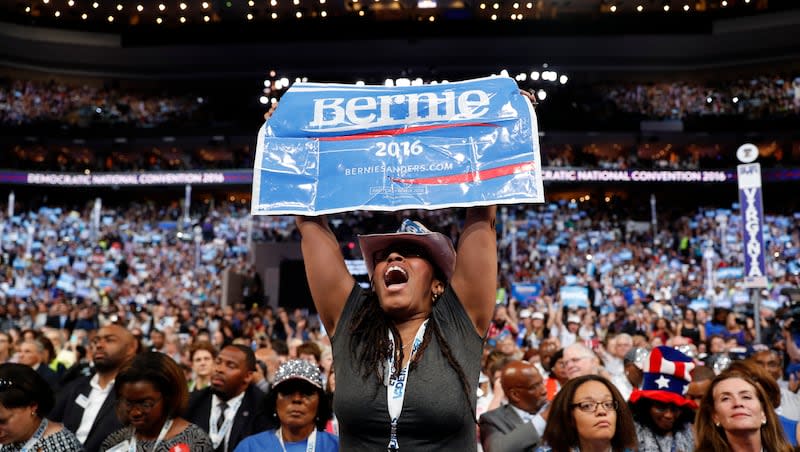More diverse than ever: How the Democratic and Republican parties have changed over the last 3 decades

A new report from Pew Research Center shows the GOP has closed the gap with Democrats on the number of voters who are registered Republicans, while both parties have become more diverse.
“Many of the factors long associated with voters’ partisanship remain firmly in place,” the report reads. “For decades, gender, race and ethnicity, and religious affiliation have been important dividing lines in politics. This continues to be the case today.”
Some notable changes, however, have affected the makeup of both parties: Republicans have made noteworthy gains among rural voters, white evangelicals and voters without a college degree, The New York Times noted. “At the same time, Democrats have held onto key constituencies, such as Black voters and younger voters, and have gained ground with college-educated voters.”
Here are five key takeaways from the report on how the Democratic and Republican parties have changed over the last three decades:
Republicans close the gap
Four years ago, leading up to the 2020 election, the Democratic Party had the “clear edge” over Republicans with 51% of voters identifying as Democrats vs. 46% identifying as Republican.
Now, leading up to the 2024 election, that gap has closed. The survey found that registered voters are now evenly split along party lines: 49% identify as Democrats or lean toward the Democratic Party and 48% identify as Republicans or lean Republican.
“In recent decades, neither party has had a sizable advantage, but the Democratic Party has lost the edge it maintained from 2017 to 2021,” according to the report.
Both parties have become more diverse
Since the 1990s, both the Republican and Democratic parties have become more diverse, the Pew report found.
In 1996, 85% of voters were White, 9% were Black, 4% were Hispanic and about 1% were Asian. Now, 67% are White, 11% are Black, 13% are Hispanic and 4% are Asian.
“Both parties are more racially and ethnically diverse than three decades ago, but not to the same degree,” according to Pew. “There has been more change in the composition of the Democratic coalition than the Republican coalition.”
However, the Democratic Party’s advantages among Black and Hispanic voters, in particular, have narrowed somewhat in recent years.
Here are how the percentage of different ethnic and racial groups have changed in both parties since 1996:
In 1996, 93% of Republicans were white. Now, 79% are white — a 14% drop. The percent of white voters dropped 21% in the Democratic party (from 77% to 56%).
The percentage of Hispanics in both parties has tripled: from 3% to 9% for Republicans and from 5% to 16% for Democrats.
Asian voters have increased from less than 1% of Democrats’ coalition to 6%.
“The share of Black voters within the Democratic coalition has remained fairly stable, and they currently make up 18% of Democratic and Democratic-leaning voters,” per Pew. Black voters make up 3% of Republicans.
While 44% of Democrat voters are Hispanic, Black, Asian, another race or multiracial, only 20% of Republicans are non-white. “However, the Democratic Party’s advantages among Black and Hispanic voters, in particular, have narrowed somewhat in recent years,” Pew found.
Church attendance linked to Republican Party — except in this group
The Pew survey found that registered voters who regularly attended religious services were more likely to identify as Republican.
“In 2023, 62% of registered voters who attended religious services once a month or more aligned with Republicans, compared with 41% of those who attend services less often,” according to the report.
This has been the pattern for years, Pew says, among white, Hispanic and Asian voters. Black voters are the exception to this trend.
“Only about one-in-ten Black voters who are regular attenders (13%) and a similar share (11%) of those who attend less often identify as Republicans or Republican leaners,” the report found.
Older voters identify, younger voters lean
While the Democratic Party has an advantage among younger voters and the Republican Party has the edge among the older generations, the study found a significant age difference in the way generations approach political parties: Older voters overwhelmingly identify with a political party, while a substantial number of younger voters say they lean towards one party or the other
“Younger voters are considerably more likely than older voters to opt out of identifying directly with a party,” according to Pew.
Among voters 80 and older, 77% identify with a party. For voters under 25, only 52% identify with a party. The other half say they are “something else or independent, with 28% leaning Democratic and 20% leaning Republican.”
Partisan gap is bigger between unmarried men and women
There is a gender gap in partisan affiliation. Men are more likely than women to associate with the Republican Party, and women tend to lean toward the Democratic party. The Pew report found that a majority of women voters continue to align with the Democratic Party, with 51% of women identifying as Democrats, and 44% as Republicans.
“Nearly the reverse is true among men (52% align with the Republican Party, 46% with the Democratic Party)” according to the report. “The gender gap is about as wide among married men and women.” However, this gap is even wider among unmarried men and women — 37% of never-married men identify as Republicans compared with 24% of never-married women.

